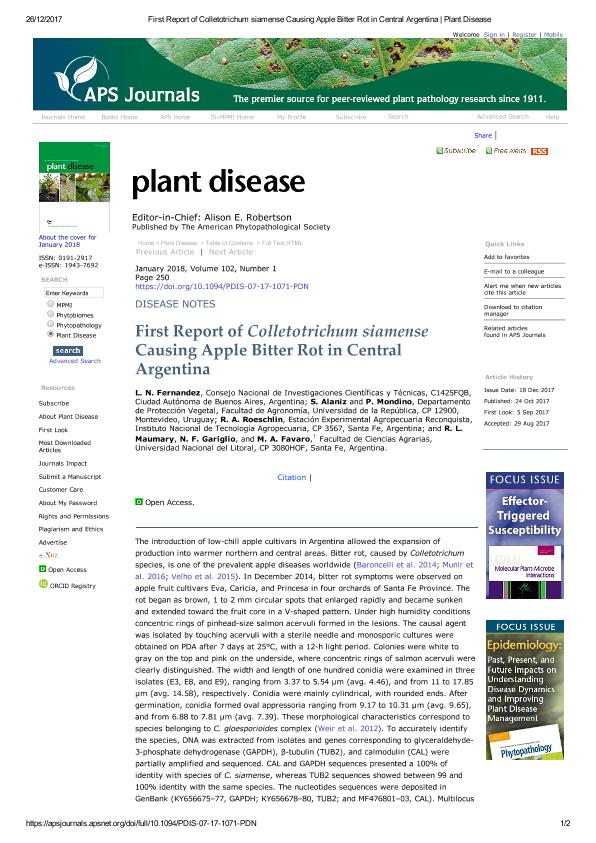Artículo
First report of Colletotrichum siamense causing apple bitter rot in central Argentina
Fernandez, Laura Noemí ; Alaniz, Sandra; Mondino, Pedro; Roeschlin, Roxana Andrea
; Alaniz, Sandra; Mondino, Pedro; Roeschlin, Roxana Andrea ; Maumary, Roxana Lorena
; Maumary, Roxana Lorena ; Gariglio, Norberto Francisco; Favaro, María Alejandra
; Gariglio, Norberto Francisco; Favaro, María Alejandra
 ; Alaniz, Sandra; Mondino, Pedro; Roeschlin, Roxana Andrea
; Alaniz, Sandra; Mondino, Pedro; Roeschlin, Roxana Andrea ; Maumary, Roxana Lorena
; Maumary, Roxana Lorena ; Gariglio, Norberto Francisco; Favaro, María Alejandra
; Gariglio, Norberto Francisco; Favaro, María Alejandra
Fecha de publicación:
01/2018
Editorial:
American Phytopathological Society
Revista:
Plant Disease
ISSN:
0191-2917
e-ISSN:
1943-7692
Idioma:
Inglés
Tipo de recurso:
Artículo publicado
Clasificación temática:
Resumen
The introduction of low-chill apple cultivars in Argentina allowed the expansion of production into warmer northern and central areas. Bitter rot, caused by Colletotrichum species, is one of the prevalent apple diseases worldwide (Baroncelli et al. 2014, Munir et al. 2016, Velho et al. 2015). In December 2014, bitter rot symptoms were observed on apple fruits cvs. ?Eva?, ?Caricia? and ?Princesa? in four orchards of Santa Fe province. The rot began as brown, 1-2 mm circular spots which enlarged rapidly and became sunken and extended toward the fruit core in a V-shaped pattern. Under high humidity conditions concentric rings of pinhead-size salmon acervuli formed in the lesions. Causal agent was isolated by touching acervuli with a sterile needle and monosporic cultures were obtained on PDA after 7 days at 25°C, with a 12-h light period. Colonies were white to gray on the top and pink on the underside, where concentric rings of salmon acervuli were clearly distinguished. The width and length of one hundred conidia were examined in three isolates (E3, E8 and E9), ranging from 3.37 to 5.54 μm (avg. 4.46), and from 11 to 17.85 μm (avg. 14.58), respectively. Conidia were mainly cylindrical, with rounded ends. After germination, conidia formed oval appressoria ranging from 9.17 to 10.31 μm (avg. 9.65), and from 6.88 to 7.81 μm (avg. 7.39). These morphological characteristics correspond to species belonging to C. gloesporioides complex (Weir et al. 2012). To accurately identify the species, DNA was extracted from isolates and genes corresponding to glyceraldehyde-3-phosphate dehydrogenase (GAPDH), ß-tubulin (TUB2) and calmodulin (CAL) were partially amplified and sequenced. CAL and GAPDH sequences presented a 100% of identity with species of Colletotrichum siamense, whereas TUB2 sequences showed between 99 and 100 % of identity with the same species. The nucleotides sequences were deposited in GenBank (KY656675-KY656677, GAPDH; KY656678-KY656680, TUB2; and MF476801-MF476803, CAL). Multilocus phylogenetic analyses performed with references sequences (Weir et al. 2012) showed that the three isolates clustered with C. siamense, in accordance with BLAST results. To confirm pathogenicity, each isolate was inoculated in eight fruits of the cultivar from which it was originally obtained. Two drops of 10 μl of conidial suspension (1x105 conidia per ml) were deposited in wounded and non-wounded areas on fruits previously disinfested with 1% sodium hypochlorite solution for 1 min and rinsed twice with sterile distilled water. Drops of sterile water were deposited in eight fruits as control. Pathogenicity tests were repeated twice. Fruits were kept under high humidity conditions at 25°C for ten days. First symptoms appeared 3 days after inoculation (DAI) in wounded areas and 5 DAI in non-wounded areas. After that, all of the isolates produced symptoms identical to those previously described, whereas the controls remain symptomless. The pathogen was re-isolated from lesions, and identified as C. siamense by morphological characteristics and based on the CAL sequences, as previously described. To our knowledge, this is the first report of C. siamense in Argentina causing bitter rot on apple. C. siamense was previously reported to be more aggressive than other Colletotrichum species, but it is also more sensitive to fungicides (Munir et al. 2016), which encourages the development of species-specific management strategies for this pathogen in central Argentina.
Palabras clave:
APPLE
,
BITTER ROT
,
MULTILOCUS PHYLOGENETIC ANALYSIS
Archivos asociados
Licencia
Identificadores
Colecciones
Articulos(CCT - SANTA FE)
Articulos de CTRO.CIENTIFICO TECNOL.CONICET - SANTA FE
Articulos de CTRO.CIENTIFICO TECNOL.CONICET - SANTA FE
Citación
Fernandez, Laura Noemí; Alaniz, Sandra; Mondino, Pedro; Roeschlin, Roxana Andrea; Maumary, Roxana Lorena; et al.; First report of Colletotrichum siamense causing apple bitter rot in central Argentina; American Phytopathological Society; Plant Disease; 102; 1; 1-2018; 1-2
Compartir
Altmétricas



